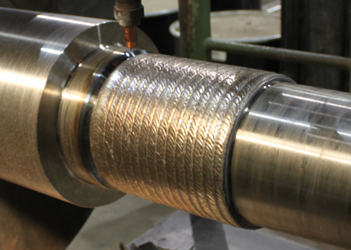

What is thermal spraying process?
Thermal spraying process is to use heat energy to melt the spraying material, and then atomize it with the help of high-speed air flow. Driven by the high-speed air flow, the particles impact the surface of the substrate and form a coating with certain functions after condensation.
More SuperHard provides a full range of thermal spray coating solution and service which includes OD grinding, inside grinding, cylindrical grinding, surface grinding and polishing, cutting tools for thermal spray coating,etc. We have been present on the Thermal Spraying Coating industry for over 10 years . Our resin diamond wheels for HVOF carbide coating has enjoyed wide popularity in Canada, Turkey, Dubai, etc. Our products cover cylindrical resin diamond wheels , diamond internal grinding wheels and flexible diamond sand belts.
Thermal spraying coating formation process:
(1) The spraying material is heated to a molten state.
(2) Spray materials are atomized into tiny droplets and hit the substrate surface at high speed. The larger the particle kinetic energy and the larger the duckweed density, the better the coating bonding.
(3) The molten high-speed particles deform after impacting the surface of the substrate and form the coating after condensation.
Thermal spraying material:
Classification and requirements of spraying materials Thermal spraying materials can be divided into wire, bar and powder three categories according to the form of materials.
Wire rod
Category | classify | classify variety |
Metal wire rod
| Non-ferrous metal | (1) Pure metals: Zn, A1, Cu, Ni, Mo (2) Alloy: Zn-A1, Pb-Sn, Cu, Babbitt, Ni alloy |
Ordinary steel and low alloy steel | Carbon steel, low alloy steel | |
High alloy steel | stainless steel, heat resistant steel | |
Bar | Ceramic bar | Al203, TiO2, Cr2O3, ZrO2, Al203+MgO, Al203+SiO2 |
Composite wire rod | Metal coated metal | aluminum coated brocade, brocade alloy |
Metal-coated ceramic | metal-coated carbide, metal-coated oxide | |
Plastic coated | plastic coated metal, plastic coated ceramic |
Metal
Species | classification |
Pure metal | Sn, Pb, Zn, A1, Cu, Ni, W, Mo, Ti, etc |
Alloy | (1) Ni-based alloy: Ni-Cr, Ni-Cu; (2)Co based alloy: CoCrW alloy (3)MCrAIY O gold: NiCrAIY, CoCrAIY, FeCrAIY (4) stainless steel (5) ferroalloy (6) copper alloy (7) Aluminum alloy (8) Babbitt alloy (9)Triballoy alloy |
Self fusible alloy | (1)Ni base self-fusible alloy: NiCrBSi, NiBSi self-fusible alloy (2)Co base self-fusible alloy: CoCrWB, CoCrWBNi(3)Fe base self-fusible alloy: FeNiCrBSi(4)Cu base self-fusible alloy |
Non-metallic type
Species | classification |
Metal oxide | (1)Al: A1203, A1203• SiO2, Al203• MgO (2)Ti: TiO2 (3)ZrA: ZrO2, ZrO2• SiO2, CaO-Zr02, MgO-ZrO2 (4)Cr: Cr203 |
Metal carbide | (1)WC, W2C (2)TiC and carbide (3)Cr302,Cr23C6 (4))B4C, SiC coated powder Ni coated Al, Ni coated metal and alloy, Ni coated ceramics |

What is the overlay welding?
Overlay welding includes two kinds of technology, spraying and spray welding, and the obtained overlays are spray coating and spray welding layer respectively. An alloy layer with special properties is fused on the surface of the metal parts. Overlay welding materials are divided into iron base, nickel base, drill base, copper base and carbonized hook base. Common overlay welding material shape and applicable overlay welding method.
The difference between thermal spraying and overlay welding is mainly shown in the following aspects:
1. Different heating conditions of the workpiece spraying without remelting process, the workpiece surface temperature can always be controlled below 250C generally does not produce deformation and make the workpiece's organizational state changes and overlay welding to melt the coating, remelting temperature can reach more than 900C, improper use of the process, easy to cause the workpiece deformation.
2. The bonding state of different spraying layer and substrate surface is mainly mechanical bite, although there is micro-zone metallurgical bonding, but the coating bonding strength is not high overlay welding through the melting of the coating and the substrate surface to form a metallurgical bonding, the bonding strength is 3-6 times that of spraying, the bonding thickness is 2-4 times that of spraying.
3. Different powder overlay welding requires the use of self-fusible alloy powder, while spraying requires less self-fusible powder.All kinds of self-fusible alloy powder can be used for overlay welding welding and spraying, but spraying powder without self-fusible can only be used for spraying and not for overlay welding process.
4. Overlaying layer structure different overlay welding layers are uniform and compact, and it is generally believed that there are no pores, while spraying layer has pore defects.
5. Bearing capacity of different spraying layers can not bear impact load and higher contact stress, mostly used in lubrication conditions of the working surface, mating surface and other working conditions with small force, overlay welding layer can bear impact load and higher contact stress, can be used in complex working conditions, can be used for line contact occasions.
---EDITOR: Doris Hu
---POST: Doris Hu
Semiconductor Industry Solutions
PCD & PCBN Tools Grinding Industry
Diamond Cutting Bruting Polishing
Add: No.171 Zhongyuan Rd, Zhongyuan District, Zhengzhou, 450001, Henan, China
Tel: +86-371-86545906
Phone / Whats App: +86 18339903057
E-mail: [email protected]



